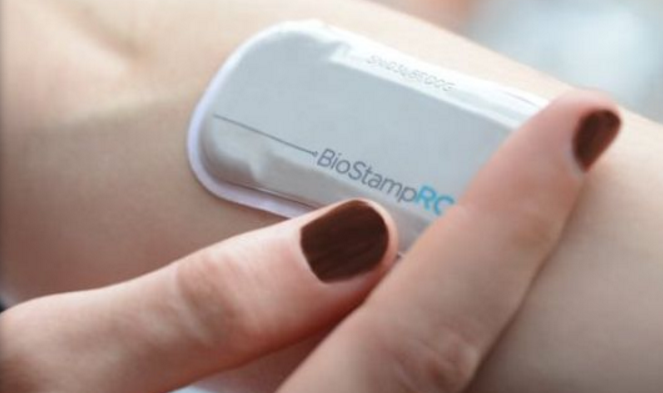MC10 BioStampRC is the first research system designed for the human body. The nation’s leading health researchers are getting a new tech tool that could transform the way we get information about the human body — from skin to skeleton.
After several years in development, the MC10 BioStampRC went on sale this week. It’s a waterproof, band-aid-like sticker loaded with some of the most sophisticated tracking sensors ever created. It provides real-time access to a person’s vital signs and activity, in an entirely unobtrusive way.
For now, it’s only available to the research community — the “RC” stands for “research connect” — but it’s a giant leap forward in the wonderful world of wearables. “The ability to capture, with research level precision, tailored data outside of a clinic…that’s the Holy Grail,” says Dr. Alvaro Pascual-Leone, Associate Dean of Harvard Medical School.
The BioStampRC system features the groundbreaking technology of the BioStamp Sensor, a body-worn sensor so flexible and soft that it naturally conforms to the contours of the human body. BioStampRC Sensors are discreet, allowing study subjects to move from lab to home, through exercise and sleep, remaining unaffected by the tightly-coupled Sensors capturing a wealth of data.
The BioStampRC system is seamlessly integrated into the researcher workflow through easily accessible tablet and web applications. Simple online study setup and on-demand pricing save valuable time and resources, enabling researchers to spend more time on finding insights.
The BioStamp weighs just under six grams, which is just a tiny bit heavier than a nickel. It’s about the same size as a business card (remember those?) and packed with next-generation technology. It uses a 3-axis accelerometer and a gyroscope to track movement, and comes loaded with sensors to monitor muscle performance and heart activity. It also has a Bluetooth radio and a tiny 15mAh battery that keeps it running for up to 36 hours before needing a charge.
“It’s the next level of sensing and accuracy,” says Dr. Leslie Saxon, Executive Director of the USC Center for Body Computing. “We’re basically taking this new technology and creating an unprecedented understanding and engagement for people around their health.”
As it gathers data, the BioStamp passes it along to researchers — and, in the future, to your doctor — via Bluetooth, providing a clear picture of your day-to-day health. This provides caregivers immediate access to real-time data or historical trends from their computer, smartphone or tablet no matter where they — or you — are. It’s like having a doctor’s visit without ever leaving the house.
Despite all the tech packed into this gadget, the fact that BioStamp sticks on almost like a child’s temporary tattoo makes it a huge step forward for healthcare. It’s easy to forget you’re wearing it at all — and researchers say that’s more important than you might think.
“When we bring patients to a laboratory, the very nature of being wired and monitored changes the testing situation,” says Dr. Pascual-Leone. “When patients aren’t hooked up to intimidating equipment, their vital signs can be different than they’re when measured in a lab.”
Current monitoring tech also gives doctors just a snapshot of a person’s health. When you visit the doctor’s office, your doctor knows how you’re doing right then — which isn’t necessarily the same as how you were doing last week. “If you have Parkinson’s and I’m your neurologist, I see you 20 to 30 minutes every six months,” says Dr. Pascual-Leone. “I get a glimpse of how you’re doing and rely on you to tell me everything else.” With BioStamp taking readings regularly, your doctors don’t have to guess at your health — they can already see it and can adjust treatment accordingly.
While many researchers plan to use BioStamp right away, it’s the future of this technology that’s really exciting: Hospital patients could wear these smart sensors instead of being stuck in bed attached to equipment. People with medical conditions could wear them at home to have a specialist monitor their wellbeing. Instead of learning about a health problem after the fact, doctors could contact patients immediately to change medications or schedule an appointment. “Personalized health care is all about having the right data, from the right patient, at the right time,” adds Dr. Saxon.
BioStamp is already unlocking a world of new medical possibilities, and teams of people are already working on the next generation of health tech devices too. Bioelectronics, where technology and biology meet, are poised to become the next, “next big thing” in healthcare. Some truly science fiction type tech is in development, like smart tattoos to measure diabetics’ glucose levels and patches that can automatically administer drugs when needed.
Research shows that sensors such as BioStamp can help lower the rate of ER visits, reduce trips to the doctor and generally keep people healthier. You won’t be able to skip this year’s check-up by wearing a smart sensor, but in a few more years you may be able to bypass all the people coughing in the waiting room. Instead, you’ll just wear a smart sensor and go over your latest health data with your doctor by video conference.
Credit: USA Today
